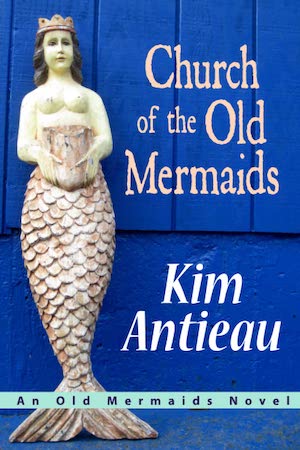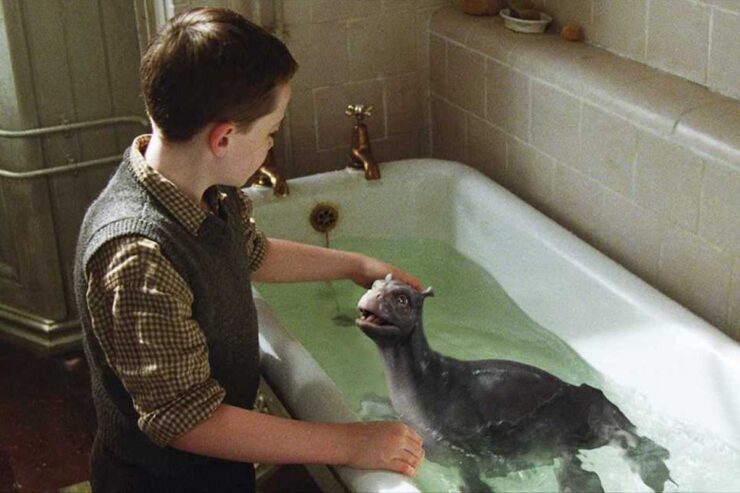Every place has its own magic, and just about every place has its own mermaids, too. Even the desert, according to Kim Antieau and her friends and fellow storytellers. The Old Mermaids were born in the writers’ community in Tucson, Arizona in the early years of this century. They’re still there, and still welcoming writers and artists to their sanctuary.
The novel that started it all is a delightful combination of magic and realism—magical realism, just the way it should be. It gives you Tucson’s landscape and people as they really are, cactus, creosote, coyotes, and all. And it gives you magic that’s as real as a flash flood roaring and rolling down a dry wash.
The heart of the novel is a geological truth. This part of Arizona was once a sea. You can still find shells high up in the mountains.
In Antieau’s world, the sea was inhabited by mermaids. When the water receded, the mermaids found themselves stranded in the dry land. Their tails shrank into legs and feet. They became, more or less, human.
They had to learn to live on the land. They built a sanctuary out of whatever they could find, and made it beautiful, because mermaids live in beauty. But humans came, and they had to learn to live in that world, which did its best to destroy what they made.
The novel begins with Myla Alvarez, woman of a certain age, ten years out from a messy divorce. Myla looks after a cluster of houses for their absentee owners, and lives in a studio apartment in the barn of one of the houses. A wash runs past them, a dry riverbed that floods during the seasonal rains.
Myla coped with her divorce by following a dream and founding the Church of the Old Mermaids. She sells treasures that she finds in the wash, setting up a table on Fourth Avenue in Tucson. With each treasure, she offers a story about the Old Mermaid who found or made or used it.
In mundane reality, they’re just flotsam. An old empty bottle, a coil of orange rope, a cracked marble. But Myla imbues them with magic.
There are thirteen Old Mermaids, living together like nuns in a convent. Their names are wicked and funny and true, like drag-queen names: Sister Sheila Na Giggles Mermaid, Sister Ursula Divine Mermaid, Mother Star Stupendous Mermaid, and one we’ve met before: Grand Mother Yemaya Mermaid. Each has her own gifts and predilections. And each has her own collection of stories.
Around the tenth anniversary of Myla’s divorce, her life changes. An old friend returns, and she begins to question some of her choices—including the reality of the Old Mermaids.
Myla has been using her employers’ houses as a literal sanctuary. She finds and shelters illegal immigrants, refugees found in the desert; she cares for them, nurses them to health, and sends them on to jobs and lives under the radar of la migra, the Border Patrol and Homeland Security. She is also, as the novel begins, looking after an abused Anglo wife and her teenaged son.
There’s danger in what Myla does, both legal and physical. She’s using her employers’ houses, which could cost her her job, at the very least—not to mention betraying their trust. And she’s doing it in the name of the Old Mermaids, who may be imaginary.
But are they?
Lily, the small daughter of one of the migrants whom Myla is sheltering, says they’re real. She sees and hears them. Myla used to think she could, too, but she isn’t sure anymore. She isn’t even sure she should continue with the Church, even without the parts that are against the law.
We learn a great deal about mermaids, and about love, and about chosen families. Antieau’s mermaids are explicitly not Little. They aren’t exactly celibate, either. We never do discover the truth about mermen, but we get the impression they sometimes have lovers.
We learn about the Old Sea from which they came, too, and how they’ve preserved it now it’s dried into desert. Mermaids’ tears are sea water, after all, and deserts flood in season, and mermaids don’t completely lose their tails. Sometimes they can bring them back. Grand Mother Yemaya Mermaid is so powerful that she even has two.
These mermaids have learned to survive in the dry land, but they never forget the sea. They’ve bridged the worlds of land and water; they inhabit a liminal space, a place between, like the borderlands they live in.
I’ve only read a very few books that capture what it’s like to live in Tucson. This one does—both the reality and the magic. It’s a strange place, compared to the temperate woodlands and northern seacoast I come from. Like the Old Mermaids, I’ve settled here. I’ve learned to live in the dry land. I’ve made it home.














